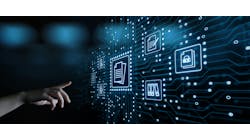In its simplest form, a digital transformation can be understood as the transition from manual processes to digital processes. However, a digital transformation can, and should, be so much more in order to get the most out of it.
Stephane Ratelet, director of Business Development/Digital Solutions in EMEA at DigiKey, explains that organizations can leverage the benefits of digital connections in order to make the right business decisions.
“When we talk about digital transformation, it could be something internal. For example, digitalizing the stock we have or the production line,” Ratelet says. “But it can also be an external connection like collecting data from a distributor, like DigiKey, or bringing in different data points that the company may need outside of the organization.”
The digital transformation goes well beyond establishing a digital connection, Ratelet continues.“‘What is digital transformation?’” Ratelet poses. “It is not only changing the current processes and saying, ‘We’re going to digitalize it.’ But it may also include, at some point, changes in management and the organization, and sometimes a change of the business model of the company to fit exactly what we would like to achieve in the future with that digital transformation.”
The Stages of Transformation
A digital transformation does not hold a binary qualification of “transformed” or “not transformed.” Rather, organizations can anticipate a journey through stages of technological growth and development from manual to digitized, assisted automation, partial automation and eventually fully automated processes.
“Automated means we want things to be automatically done,” Ratelet emphasizes. “Most importantly, the first requirement is to have a digital signal to do it.”
Ratelet likens the digital transformation of a business to a vehicle’s evolution with respect to autonomous driving.
“You cannot have, for example, cruise control if you first do not digitalize the speed of the car,” he says. “And you cannot have adaptive cruise control if you do not digitalize the distance with the car that is in front of you. Digital is the first step. And once we’ve digitalized, we can go automated. Being fully digitally transformed means that we’ve digitalized, but we’ve also moved forward with automation.”
If we continue with the autonomous driving example, we can reference a scale from zero to five that’s been defined by SAE International. SAE J3016 defines the SAE Levels from Level 0 (no driving automation) to Level 5 (full driving automation) in the context of motor vehicles and their operation on roadways.
You can refer to the chart below as a representation of this scaling as it pertains to the industry.
Drawing the Digital Transformation Roadmap
To undergo such an alteration in business operations, it pays to think ahead. Understand not only where you want to land, but what it will take to get there.
“I have seen companies trying to digitalize their current processes. It’s a good solution in the short term, but it’s probably not in the long term,” Ratelet states. “To start the journey, it’s better to first think about the future of the company business model, then how the processes will look and then the digital signals needed to perform it.
“Consider also what could be the change in management that will occur based on this, as well as the obstacles, and then draw the roadmap,” he continues. “It’s not just saying, ‘We’re going to digitize this.’ No. This impacts the company much more deeply.”
Ratelet further posits that this process cannot be undertaken with the strategy of just digitalizing information or processes. It also requires “thinking digitally to next be able to automate. Because that is going to be the next step if companies want to stay competitive in the market.”
Beginning the Digital Transformation
When considering which areas of the business should take the first steps along the digital transformation journey, Ratelet suggests starting with quoting activities.
“If companies want to increase business with their end customers, they first have to be able to quote what they can provide,” he says. “It’s time consuming, and usually only 10-20% of these quotes will be transformed into business. Companies have to make sure that they are efficient on the quoting piece of operations by automatically collecting information from different distributors in order to send the end customer the right quote to win business and to develop relationships.”
The ordering processes should be next in line. Digitalizing ordering systems throughout one’s supply chain as well as ensuring the capability to place, schedule, reschedule and track orders will move operations forward with expediency.
Beware the Data
In order to digitalize procedures, quality sources of information and data will be of paramount importance. Ratelet cautions businesses to do their due diligence when sourcing their data.
“Make sure to select the right source of information and to define the right way to collect that data,” he says. “I have seen customers moving forward in the wrong direction with inaccurate development language, for example, and finally, they are stuck with what we call a technological debt. After that, it’s hard to move forward.”
The problem is that it is not easy to define the good data from the bad. However, accuracy and timeliness are great measures to apply in order to grade a dataset.
“The worst-case scenario is when the data is not updated; when the pricing is wrong and when the lead time is wrong,” Ratelet states. “If the lead time is wrong, for example, it means the customer will place an order too early or too late. If it’s too early, they expose the cash flow; and if it’s too late, they expose themselves to shortages. Or it could be the pricing, meaning that you’d receive something that is not accurate and it creates a digital disruption. As soon as you have wrong information, you need a human to step in and try to figure out what’s going on.”
Tools and Technologies of Digitally Minded Business
Many businesses have historically been quite cautious about opening up and connecting with the outside world. Luckily, technologies and tools exist today that not only make this process easier and safer, but also propel operations forward with efficiency and growth.
In the distribution market, Ratelet says more and more digital connectivity is becoming available regularly.
“This is something that is now expected across the market,” he reinforces. “The availability of those digital connections across the market is something that is definitely an enabler for customers. If they want to go digital and automate and push automation, they would like to do this with everybody, not just with a few parties.”
Enterprise Resource Planning (ERP) software has been evolving alongside businesses over the past few years, which helps to serve a digitally transformative organization.
“We are now starting to have cloud-based solutions. We also have ERPs capable of embedding third-party applications and ERPs that are more open to connect to application programming interfaces (APIs) or to external connections, even if it is with enterprise service bus (ESB) at some point. This too is an enabler,” Ratelet confers.
“When we think about the technology that is available outside of the ERP, we start to have more and more software companies that can be part of the ecosystem,” he continues. “Some can provide turnkey solutions to their customers. For example, there is software design for quoting activities where the customer can pay a monthly fee, get training for one day and immediately have something available that is capable to connect to the world market and provide a lot of value without having the need to develop or extensively train people to work with it. These are technology enablers.”
Digital Connections with DigiKey
For organizations looking to establish digital connectivity with distributors, such as DigiKey, it is good to know both the tools available and how they can better serve business operations.
DigiKey has many APIs that allow for digital transformation in the way customers can engage with their offerings. Ratelet explains the benefits realized by those who have integrated the company’s APIs into their practices.
“It is a way to reduce the cost of the manual processes that they had before and, as a result, they are able to focus on more strategic tasks, delivering added value,” he states. “Customers have also experienced a reduction in the time it takes to receive updated information. When you shift from checking prices on the web and move to DigiKey’s API where you can click one button and get everything in less than a minute, this reduced time to receive the information increases efficiency.
“The efficiency and accuracy of the data raises the speed of execution in the company,” Ratelet adds, “and as a result, increases the time to market, which we know is a key factor to win business nowadays.”
DigiKey’s APIs offer access to accurate and timely data, information vital to business attempting to operate in the digital world of today and tomorrow.
“To be able to base decisions on relevant information, and not on data that maybe sits on a database for weeks or months, is extremely important because we know that the fluctuation of the data is very high these days,” Ratelet concludes. “In the last two years, availability data has become critical—you want to know when and where stock is available.”
Visit DigiKey.com/API, where a dedicated landing page showcases what the company can provide and which processes can be digitalized for your business. The page hosts videos, FAQs, a list of third-party partners and other resources. There is even an ROI calculator on the page that allows customers to estimate what the return on investment could be by digitalizing their processes.











